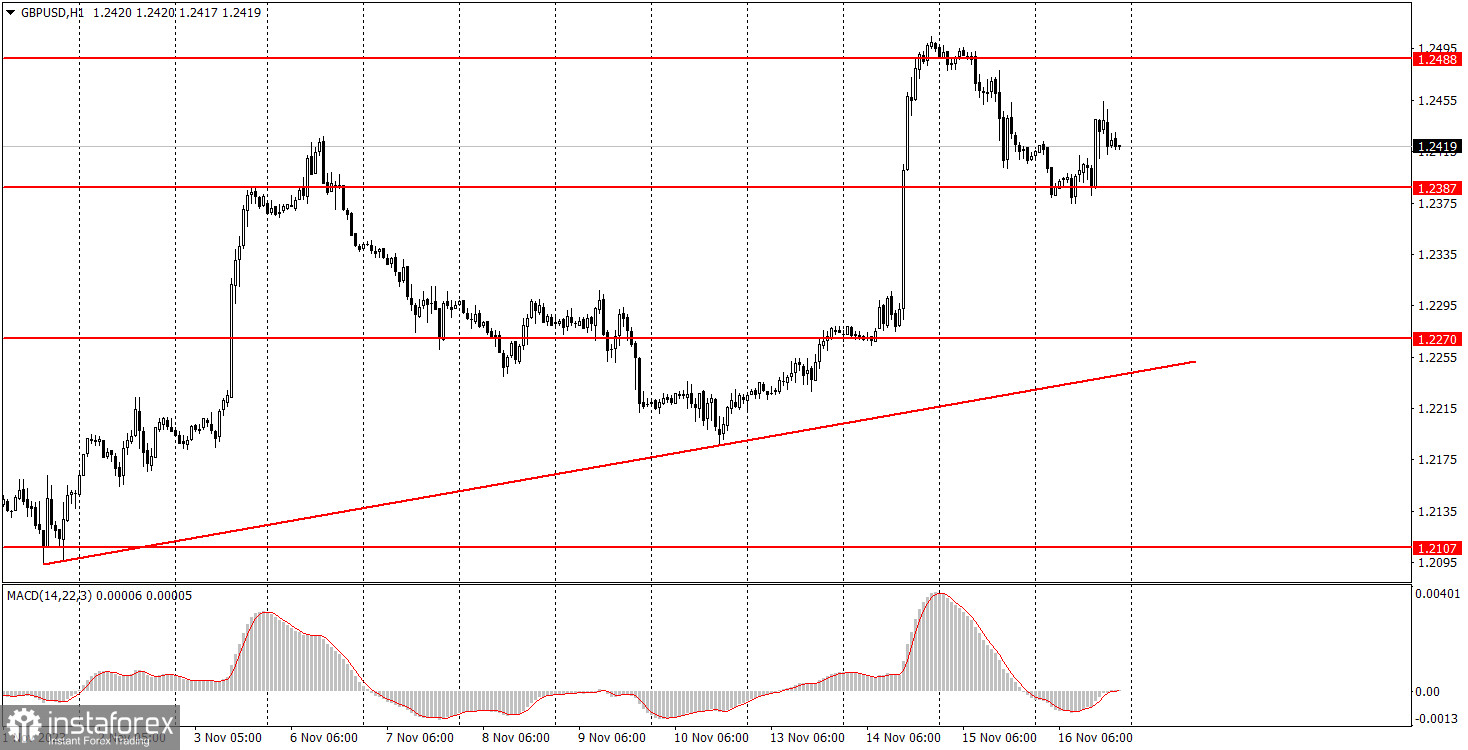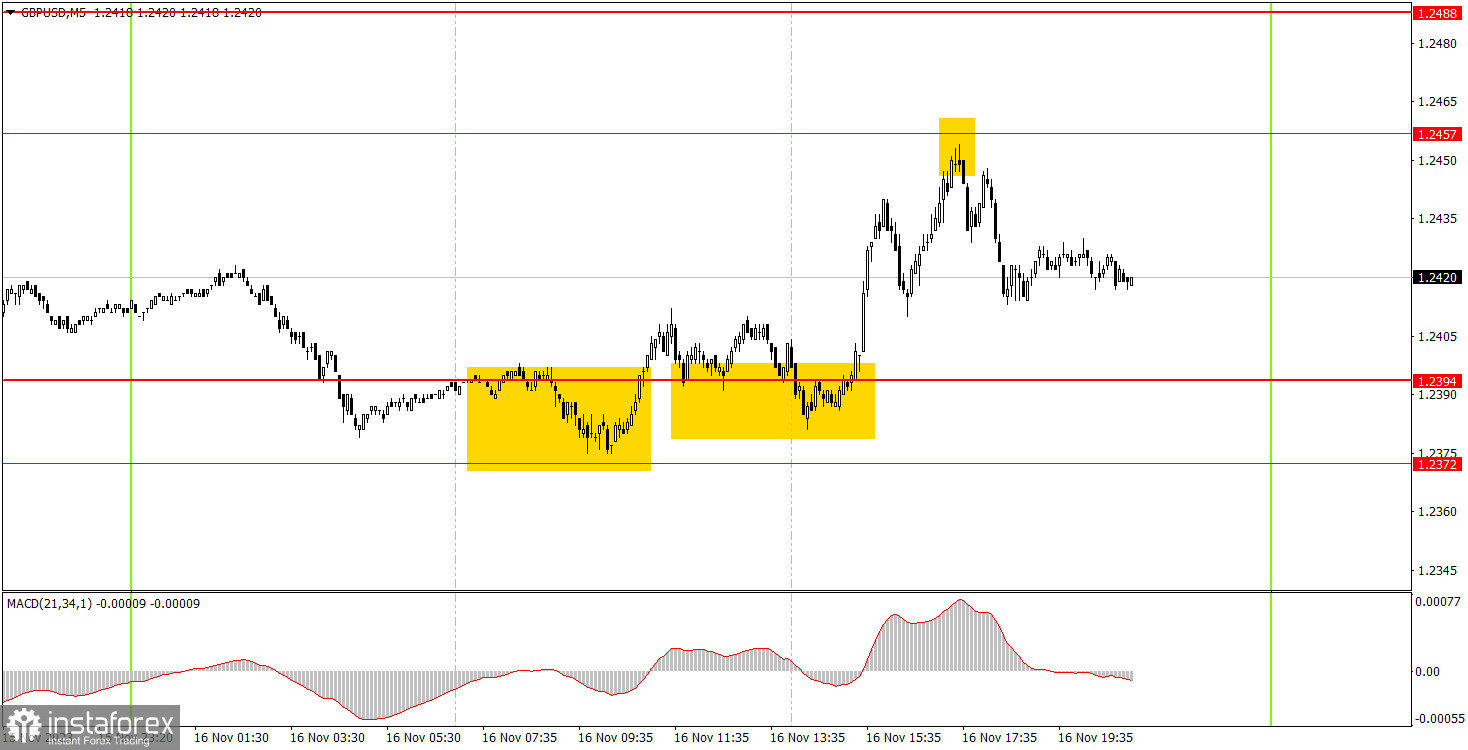Analyzing Thursday's trades:
GBP/USD on 30M chart

On Thursday, GBP/USD tried to start a corrective movement but failed to overcome the nearest level and bounced. The U.S. reports played a significant role here. Two important U.S. reports turned out worse than expected, and the dollar fell during the U.S. session. We have previously mentioned that several reports from the U.S. have turned out to be disappointing, which pushed both major currency pairs to rise. A new ascending trend line has also been formed, clearly indicating a short-term uptrend. At present, there are no signals for the revival of the medium-term downtrend, but that is what we are waiting for.
GBP/USD on 5M chart

On the 5-minute chart, three trading signals were generated. Initially, the pair bounced twice from the 1.2372-1.2394 area. In the first case, it even failed to move in the intended direction by 20 pips, so by the time the second signal was formed, traders had to stay in long positions. In the second case, the price finally started to rise and almost reached the level of 1.2457, from which it bounced. The error was only 3 pips, which is acceptable. Thus, long positions could earn about 30-40 pips. The bounce from the level of 1.2457 could also be used to open short positions, after which the pair fell by about 15-20 pips. This trade should have been manually closed in the evening.
Trading tips on Friday:
On the 30-minute chart, the GBP/USD pair sharply and unexpectedly resumed its upward movement. But we still believe that it will end soon. Initially, we expected a more pronounced correction, and in the last week, the downtrend resumed. But in both cases, U.S. data interfered, and we also have the market's inadequate reaction to the reports. The key levels on the 5M chart are 1.2052, 1.2089-1.2107, 1.2164-1.2179, 1.2235, 1.2270, 1.2310, 1.2372-1.2387, 1.2457-1.2488, 1.2544, 1.2605-1.2620, 1.2653, 1.2688, 1.2748. Once the price moves 20 pips in the right direction after opening a trade, you can set the stop-loss at breakeven. On Friday, the UK will release a retail sales report, and the U.S. will release a minor report on building permits. Both reports are not crucial, but they may cause a small reaction.
Basic trading rules:
1) Signal strength is determined by the time taken for its formation (either a bounce or level breach). A shorter formation time indicates a stronger signal.
2) If two or more trades around a certain level are initiated based on false signals, subsequent signals from that level should be disregarded.
3) In a flat market, any currency pair can produce multiple false signals or none at all. In any case, the flat trend is not the best condition for trading.
4) Trading activities are confined between the onset of the European session and mid-way through the U.S. session, after which all open trades should be manually closed.
5) On the 30-minute timeframe, trades based on MACD signals are only advisable amidst substantial volatility and an established trend, confirmed either by a trendline or trend channel.
6) If two levels lie closely together (ranging from 5 to 15 pips apart), they should be considered as a support or resistance zone.
How to read charts:
Support and Resistance price levels can serve as targets when buying or selling. You can place Take Profit levels near them.
Red lines represent channels or trend lines, depicting the current market trend and indicating the preferable trading direction.
The MACD(14,22,3) indicator, encompassing both the histogram and signal line, acts as an auxiliary tool and can also be used as a signal source.
Significant speeches and reports (always noted in the news calendar) can profoundly influence the price dynamics. Hence, trading during their release calls for heightened caution. It may be reasonable to exit the market to prevent abrupt price reversals against the prevailing trend.
Beginners should always remember that not every trade will yield profit. Establishing a clear strategy coupled with sound money management is the cornerstone of sustained trading success.
 English
English 
 Русский
Русский Bahasa Indonesia
Bahasa Indonesia Bahasa Malay
Bahasa Malay ไทย
ไทย Español
Español Deutsch
Deutsch Български
Български Français
Français Tiếng Việt
Tiếng Việt 中文
中文 বাংলা
বাংলা हिन्दी
हिन्दी Čeština
Čeština Українська
Українська Română
Română

